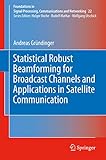Statistical Robust Beamforming for Broadcast Channels and Applications in Satellite Communication [electronic resource] / by Andreas Gründinger.
By: Gründinger, Andreas [author.] .
.
Contributor(s): SpringerLink (Online service) .
.
Material type:  BookSeries: Foundations in Signal Processing, Communications and Networking: 22Publisher: Cham : Springer International Publishing : Imprint: Springer, 2020Edition: 1st ed. 2020.Description: XXV, 245 p. 42 illus. in color. online resource.Content type: text Media type: computer Carrier type: online resourceISBN: 9783030295783.Subject(s): Signal processing
BookSeries: Foundations in Signal Processing, Communications and Networking: 22Publisher: Cham : Springer International Publishing : Imprint: Springer, 2020Edition: 1st ed. 2020.Description: XXV, 245 p. 42 illus. in color. online resource.Content type: text Media type: computer Carrier type: online resourceISBN: 9783030295783.Subject(s): Signal processingIntroduction -- Multi-User Downlink Communication -- Models for Incomplete Channel Knowledge -- Precoder Design for Ergodic Rates with Multiplicative Fading 53 -- Average Mean Square Error Transceiver Design for Additive Fading -- Outage Constrained Beamformer Design -- Applications in Satellite Communication -- Summary, Conclusions, and Open Research on Robust Beamforming -- Conclusion.
This book investigates adaptive physical-layer beamforming and resource allocation that ensure reliable data transmission in the multi-antenna broadcast channel. The book provides an overview of robust optimization techniques and modelling approximations to deal with stochastic performance metrics. One key contribution of the book is a closed-form description of the achievable rates with unlimited transmit power for a rank-one channel error model. Additionally, the book provides a concise duality framework to transform mean square error (MSE) based beamformer designs, e.g., quality of service and balancing optimizations, into equivalent uplink filter designs. For the algorithmic solution, the book analyses the following paradigm: transmission to receivers with large MSE targets (low demands) is switched off if the transmit power is low. The book also studies chance constrained optimizations for limiting the outage probability. In this context, the book provides two novel conservative outage probability approximations, that result in convex beamformer optimizations. To compensate for the remaining inaccuracy, the book introduces a post-processing power allocation. Finally, the book applies the introduced beamformer designs for SatCom, where interference from neighboring spotbeams and channel fading are the main limitations.


There are no comments for this item.